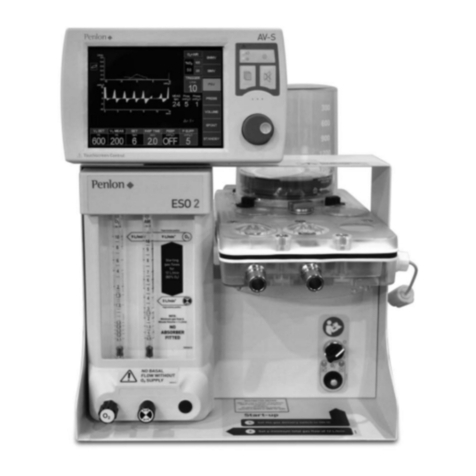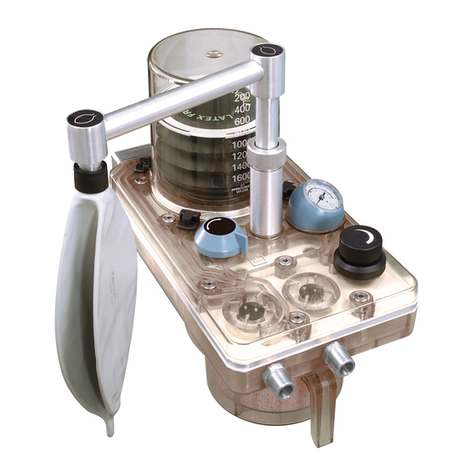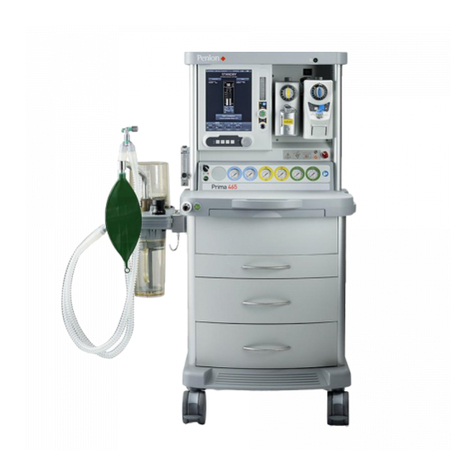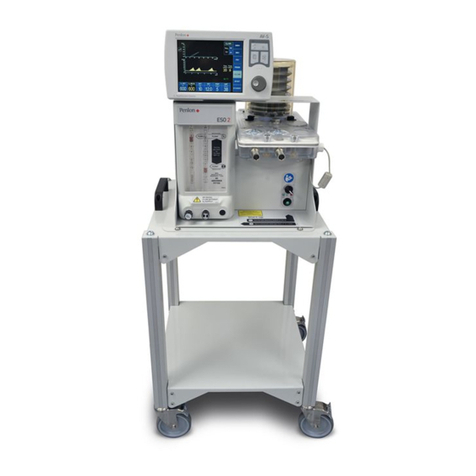
Prma 320 Advance 3 User Manual
Do not use the system solely to provde large flows of
oxygen, va the auxlary gas outlets, to external devces
whch may not be equpped wth a supply falure alarm
16 The system must not be ftted wth more than three
operator accessble mans socket outlets There s a
rsk of an excessve leakage current Ths can result n a
reduced level of safety
17 Be aware that when equpment s connected to an
auxlary outlet, a medcal electrcal system s created as
defned n IE 60601-1-1 (Refer to auton 8)
18 On machnes wth ppelne connectons, be aware that a
malfuncton of the central gas supply wthn your faclty
may cause mmedate cessaton of gas delvery and total
anaesthesa system falure
19 The use of antstatc or electrcally conductve breathng
hoses s not recommended when usng hgh frequency
electrcal surgery equpment (eg Dathermy) Burns
may be caused
To avod the rsk of electrc shock, ths system must only
be connected to a mans supply wth a protectve earth
Before any electrcally powered machne s used clncally
for the frst tme, check that the hosptal engneerng
department has carred out an earth contnuty test
20 Before usng any addtonal electrcal equpment powered
by the auxlary sockets on the machne, a traned
engneer must check that the addtonal equpment s
correctly wred and s earthed through ts plug
In the event of malfuncton of any devce powered by the
auxlary sockets, a traned engneer must check the
devce and machne fuses
21 A mssng or defectve protectve earth conductor may
ncrease earth leakage currents to the patent to values
exceedng the allowable lmts, resultng n ventrcular
fbrllaton, or nterference wth the pumpng acton of the
heart
22 Portable RF communcatons equpment (ncludng
perpherals such as antenna cables and external
antennas) should be used no closer than 30 cm (12
nches) to any part of ths devce, ncludng cables
specfed by the manufacturer Otherwse, degradaton of
the performance of ths equpment could result
23 Addtonal equpment placed on the top shelf must be
securely attached
Take care when movng a fully loaded machne,
partcularly when negotatng ramps
heck that hoses or power leads are not tralng on the
floor
24 Accessores must be removed before the machne s
transported
25 MRI compatblty - The Prma 320 Advance s not MRI
compatble
26 To prevent patent nury n the event of total anaesthesa
system falure, an alternatve means of ventlaton must
be avalable whenever the devce s n use
27 The Apnea alarm s a vsual, onscreen alarm (no audo
functon), and s actve only n SPONT/PSV mode
28 User mantenance
User Mantenance s restrcted to cleanng the external
surfaces of the machne (see Secton 72)
All other mantenance and servcng and the replacement
of components, ncludng fuses and the mans electrcal
cable, must be carred out only by Penlon-traned
engneers
AUTIONS
1 Flowmeter needle valves are desgned to seal wth lght
torque and may be damaged f tghtened excessvely
Do not force the control knob past ether the fully open or
fully closed postons
2 Open cylnder valves slowly to avod damage to pressure
reducng valves
Ensure that cylnder valves are at least one full turn open
when n use
3 Do not use anaesthetc agents for cleanng purposes
4 After use, always dsconnect the machne from the pped
gas supply and/or close the gas cylnder valves
5 Ant-hypoxc devce (AHD) system - The oxygen flow
control s restrcted to prevent the needle valve from fully
closng Ths ensures a mnmum basal flow of oxygen
DO NOT attempt to close the flow to zero
Do not overtghten
6 ompressed gas supples must be clean and dry
7 When the auxlary gas outlets are n use on a machne
usng cylnder supply only (e If the ppelne supply s not
n use), check flow rate requrements, and ensure that
adequate back-up cylnders are avalable
8 The requrements of IE 60601-1-1 apply to any devce
connected to the auxlary electrcal sockets Users must
be aware of the rsks of ncreased leakage currents when
equpment s connected to the auxlary power sockets
9 Do not apply excessve pressure to the dsplay screens
10 onnect the external OMMS outlet only to approved
devces usng protocol provded by Penlon Ltd ontact
Techncal Support Department for detals
11 Vaporzers Read the nstructon manual suppled wth
the vaporzer before clncal use
NOTE
1 Refer to Appendx 3 for labellng and symbols
Warnings and Cautions































